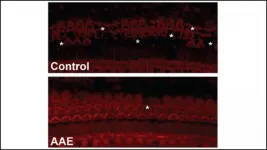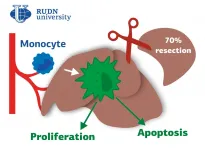The Science of tsunamis
Mechanical engineer Alban Sauret and colleagues develop a model to better understand the forces that generate these devastating waves
2021-06-21
(Press-News.org) The word "tsunami" brings immediately to mind the havoc that can be wrought by these uniquely powerful waves. The tsunamis we hear about most often are caused by undersea earthquakes, and the waves they generate can travel at speeds of up to 250 miles per hour and reach tens of meters high when they make landfall and break. They can cause massive flooding and rapid widespread devastation in coastal areas, as happened in Southeast Asia in 2004 and in Japan in 2011.
But significant tsunamis can be caused by other events as well. The partial collapse of the volcano Anak Krakatau in Indonesia in 2018 caused a tsunami that killed more than 400 people. Large landslides, which send immense amounts of debris into the sea, also can cause tsunamis. Scientists naturally would like to know how and to what extent they might be able to predict the features of tsunamis under various circumstances.
Most models of tsunamis generated by landslides are based on the idea that the size and power of a tsunami is determined by the thickness, or depth, of the landslide and the speed of the "front" as it meets the water. In a paper titled "Nonlinear regimes of tsunami waves generated by a granular collapse," published online in the Journal of Fluid Mechanics, UC Santa Barbara mechanical engineer Alban Sauret and his colleagues, Wladimir Sarlin, Cyprien Morize and Philippe Gondret at the Fluids, Automation and Thermal Systems (FAST) Laboratory at the University of Paris-Saclay and the French National Centre for Scientific Research (CNRS), shed more light on the subject. (The article also will appear in the journal's July 25 print edition.)
This is the latest in a series of papers the team has published on environmental flows, and on tsunami waves generated by landslides in particular. Earlier this year, they showed that the velocity of a collapse -- i.e., the rate at which the landslide is traveling when it enters the water -- controls the amplitude, or vertical size, of the wave.
In their most recent experiments, the researchers carefully measured the volume of the granular material, which they then released, causing it to collapse as a cliff would, into a long, narrow channel filled with water. They found that while the density and diameter of the grains within a landslide had little effect on the amplitude of the wave, the total volume of the grains and the depth of the liquid played much more crucial roles.
"As the grains enter the water, they act as a piston, the horizontal force of which governs the formation of the wave, including its amplitude relative to the depth of the water," said Sauret. (A remaining challenge is to understand what governs the speed of the piston.) "The experiments also showed that if we know the geometry of the initial column [the material that flows into the water] before it collapses and the depth of the water where it lands, we can predict the amplitude of the wave."
The team can now add this element to the evolving model they have developed to couple the dynamics of the landslide and the generation of the tsunami. A particular challenge is to describe the transition from an initial dry landslide, when the particles are separated by air, to an underwater granular flow, when the water has an important impact on particle motion. As that occurs, the forces acting on the grains change drastically, affecting the velocity at which the front of grains that make up the landslide enters the water.
Currently, there is a large gap in the predictions of tsunamis based on simplified models that consider the field complexity (i.e., the geophysics) but do not capture the physics of the landslide as it enters the water. The researchers are now comparing the data from their model with data collected from real-life case studies to see if they correlate well and if any field elements might influence the results.
INFORMATION:
ELSE PRESS RELEASES FROM THIS DATE:
2021-06-21
Following fertilization, early plant embryos arise through a rapid initial diversification of their component cell types. As a result, this series of coordinated cell divisions rapidly sculpts the embryo's body plan. The developmental phenomenon in question is orchestrated by a transcriptional activation of the plant genome. However, the underlying cellular differentiation programs have long remained obscured as the plant embryos were hard to isolate. In fact, previous attempts at creating datasets of the plant embryonic differentiation programs were incapable ...
2021-06-21
A commonly studied perovskite can superfluoresce at temperatures that are practical to achieve and at timescales long enough to make it potentially useful in quantum computing applications. The finding from North Carolina State University researchers also indicates that superfluorescence may be a common characteristic for this entire class of materials.
Superfluorescence is an example of quantum phase transition - when individual atoms within a material all move through the same phases in tandem, becoming a synchronized unit.
For example, when atoms in an optical material such as a perovskite are excited they can individually radiate light, create energy, and fluoresce. Each atom will start moving through these phases randomly, but given the right conditions, they can synchronize in ...
2021-06-21
All plant cells obtain their energy mainly from two organelles they contain - chloroplasts (responsible for photosynthesis) and mitochondria (responsible for the biochemical cycle of respiration that converts sugars into energy). However, a large number of a plant cell's genes in its mitochondria and chloroplasts can develop defects, jeopardising their function. Nevertheless, plant cells evolved an amazing tool called the RNA editosome (a large protein complex) to repair these kinds of errors. It can modify defective messenger RNA that result from defective DNA by transforming (deamination) of certain mRNA nucleotides.
Automatic error correction in plant cells
Automatic error correction in plants was discovered about 30 years ago by a team headed by plant physiologist Axel Brennicke ...
2021-06-21
While the LGBTQ+ community has seen significant advancements in legal rights, political representation and social acceptance over recent years, mental and physical health disparities still exist for queer Americans - and are even worse among younger generations, says a new study from Michigan State University.
In the first-ever population-based national study comparing mental and physical health of lesbian, gay and bisexual (LGB) Americans to their straight counterparts, MSU sociologist Hui Liu and research partner Rin Reczek, professor of sociology from Ohio State University, found that when compared to their straight counterparts, LGB Millennials have worse health disadvantages than their older peers, though disparities persist throughout older generations as ...
2021-06-21
All coronaviruses produce four primary structural proteins and multiple nonstructural proteins. However, the majority of antibody-based SARS-CoV-2 research has focused on the spike and nucleocapsid proteins. A study published in PLOS Biology by Anna Heffron, Irene Ong and colleagues at the University of Wisconsin-Madison, USA, suggests that immune responses may develop against other proteins produced by the SARS-CoV-2 virus.
The efficacy of spike protein-based vaccines is variable and not everyone infected with SARS-CoV-2 produces detectable antibodies against the spike or ...
2021-06-21
In a new study published today in the American Journal of Human Genetics, researchers announced the development of a new method to increase the utility and equity of large genetic databases. The research was conducted by Audrey Hendricks, an associate professor of statistics at the University of Colorado Denver (CU Denver).
Summix, the new method developed by Hendricks and her team of CU Denver undergraduate and graduate students, estimates the genetic ancestry in databases and adjusts the information to match the ancestry of a person or sample of people. This method leads large genetic databases to become more useful for people of various ancestries such as African American or Latinx, as they are underrepresented in genetic ...
2021-06-21
Every day, our bodies face a bombardment of UV rays, ozone, cigarette smoke, industrial chemicals and other hazards.
This exposure can lead to free-radical production in our bodies, which damages our DNA and tissues. A new study from West Virginia University researcher Eric E. Kelley--in collaboration with the University of Minnesota--suggests that unrepaired DNA damage can increase the speed of aging.
The study appears in the journal Nature.
Kelley and his team created genetically-modified mice with a crucial DNA-repair protein missing from their hematopoietic stem cells, immature immune cells that develop into white blood cells. Without this ...
2021-06-21
Broadband sounds embedded with short pauses can maintain temporal sound processing in a mouse model of hearing loss, according to new research published in eNeuro.
Hearing loss treatments supplement auditory system function but don't repair it. However a new intervention -- playing broadband sounds during the onset of hearing loss -- may be able to prevent the damage from ever occurring. Augmented auditory environments have been able to preserve auditory processing of a wide range of sound frequencies in mice models. In a new study, Dziorny et al. modified the traditional paradigm and preserved the processing of time-related, or temporal, sound features which are vital for understanding speech.
The research team exposed mice with congenital hearing loss to ...
2021-06-21
DURHAM, N.C. - In the fight against viruses, antibodies have the potential to either block infection or enable infection and make the disease worse, leading to concern about their use as a therapy for COVID-19.
In a study published in the journal END ...
2021-06-21
RUDN University doctors found out what role macrophages play in the recovery of the liver after the removal of its significant part. The results are published in the journal Biomedicine & Pharmacotherapy.
The liver in mammals is the most regenerative internal organ. It can restore the original size from as little as 25% of the preserved tissue. An important role in this process is played by macrophages. These are the cells that can engulf and digest particles. It is known, for example, that if the liver is affected by foreign substances, including drugs, macrophages migrate to the liver, absorb harmful microorganisms and dead cells, cause inflammation and thus contribute to the restoration of the organ. However, it is still unknown unambiguously how macrophages affect the ...
LAST 30 PRESS RELEASES:
[Press-News.org] The Science of tsunamis
Mechanical engineer Alban Sauret and colleagues develop a model to better understand the forces that generate these devastating waves



